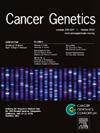A novel POT1-TPD presentation: A germline pathogenic POT1 variant discovered in a patient with newly diagnosed posterior fossa ependymoma
IF 2.1
4区 医学
Q4 GENETICS & HEREDITY
引用次数: 0
Abstract
Introduction
POT1 tumor predisposition (POT1-TPD) is an autosomal dominant disorder characterized by increased lifetime malignancy risk. Melanoma, angiosarcoma, and chronic lymphocytic leukemia are the most frequently reported malignancies [1]. Protection of telomeres protein 1 (POT1) is part of the shelterin protein complex to maintain/protect telomeres [2]. Proposed mechanisms for oncogenesis with POT1 loss of function include telomere elongation and DNA damage response causing genomic instability [3]. Ependymomas are a heterogeneous group representing one-third of pediatric brain tumors and are locally aggressive with frequent recurrence [4].
Case presentation
A healthy 3-year-old male presented with worsening vertigo, headaches, and emesis. Radiographic studies demonstrated a midline posterior fossa mass in the fourth ventricle. Following a gross total resection, pathology demonstrated a posterior fossa ependymoma, group A. Next generation sequencing (NGS) using our institution's clinically validated panel, “CinCSeq,” identified a POT1 splice site variant (c.1164–1G>A; variant allele fraction 46 %). Paired germline testing via the Molecular Characterization Initiative confirmed this variant as heterozygous in the patient. Genetic testing confirmed the POT1 pathogenic variant in his mother, who has a history of multiple nevi. The patient completed treatment with focal proton radiotherapy with no evidence of disease recurrence to date.
Discussion
To our knowledge, this represents the first documented pediatric ependymoma patient with a familial, germline POT1 pathogenic variant. Somatic POT1 mutational frequency, as determined by NGS in over 60,000 solid tumors, is 2.94 %. Among this cohort, 48 cases were ependymomas with one non-benign POT1 mutation [5]. Alterations of telomere maintenance have been reported in intracranial ependymomas previously through increased human telomerase reverse transcriptase (hTERT) expression [6,7]. This case sheds light on a potential new predisposition for ependymoma development and the expanding phenotype of POT1-TPD. We recognize the POT1 pathogenic variant may have been discovered incidentally in this case. Further research is needed to advance our understanding of the association between POT1 genetic alterations and ependymomas.
一种新的POT1- tpd表现:在新诊断的后窝室管膜瘤患者中发现了种系致病性POT1变异。
POT1肿瘤易感性(POT1- tpd)是一种常染色体显性遗传病,其特征是终生恶性肿瘤风险增加。黑色素瘤、血管肉瘤和慢性淋巴细胞白血病是最常见的恶性肿瘤。保护端粒蛋白1 (POT1)是维持/保护端粒[2]的庇护蛋白复合物的一部分。POT1功能丧失的肿瘤发生机制包括端粒延伸和DNA损伤反应导致基因组不稳定[3]。室管膜瘤是一个异质性的群体,占儿童脑肿瘤的三分之一,局部侵袭性强,经常复发。病例介绍:一名健康的3岁男性,表现为眩晕、头痛和呕吐加重。x线检查显示第四脑室后颅窝中线肿块。在大体全切除后,病理显示为a组后窝室管膜瘤。使用我们机构的临床验证小组“CinCSeq”的下一代测序(NGS)鉴定出POT1剪接位点变异(c.1164-1G> a;变异等位基因比例46%)。通过分子表征计划进行的配对生殖系检测证实该变体在患者中为杂合子。基因检测证实他的母亲携带POT1致病变异,她有多痣病史。患者完成局灶质子放疗治疗,至今无疾病复发迹象。讨论:据我们所知,这是第一例记录的具有家族性种系POT1致病性变异的儿科室管膜瘤患者。在60000多个实体瘤中,通过NGS测定的体细胞POT1突变频率为2.94%。在该队列中,48例室管膜瘤伴1例非良性POT1突变[5]。在颅内室管膜瘤中,端粒维持的改变曾被报道过,其原因是人端粒酶逆转录酶(hTERT)表达增加[6,7]。本病例揭示了室管膜瘤发展和POT1-TPD扩大表型的潜在新易感性。我们认识到,POT1致病性变异可能是偶然发现的。需要进一步的研究来加深我们对POT1基因改变与室管膜瘤之间关系的理解。
本文章由计算机程序翻译,如有差异,请以英文原文为准。
求助全文
约1分钟内获得全文
求助全文
来源期刊

Cancer Genetics
ONCOLOGY-GENETICS & HEREDITY
CiteScore
3.20
自引率
5.30%
发文量
167
审稿时长
27 days
期刊介绍:
The aim of Cancer Genetics is to publish high quality scientific papers on the cellular, genetic and molecular aspects of cancer, including cancer predisposition and clinical diagnostic applications. Specific areas of interest include descriptions of new chromosomal, molecular or epigenetic alterations in benign and malignant diseases; novel laboratory approaches for identification and characterization of chromosomal rearrangements or genomic alterations in cancer cells; correlation of genetic changes with pathology and clinical presentation; and the molecular genetics of cancer predisposition. To reach a basic science and clinical multidisciplinary audience, we welcome original full-length articles, reviews, meeting summaries, brief reports, and letters to the editor.
 求助内容:
求助内容: 应助结果提醒方式:
应助结果提醒方式:


